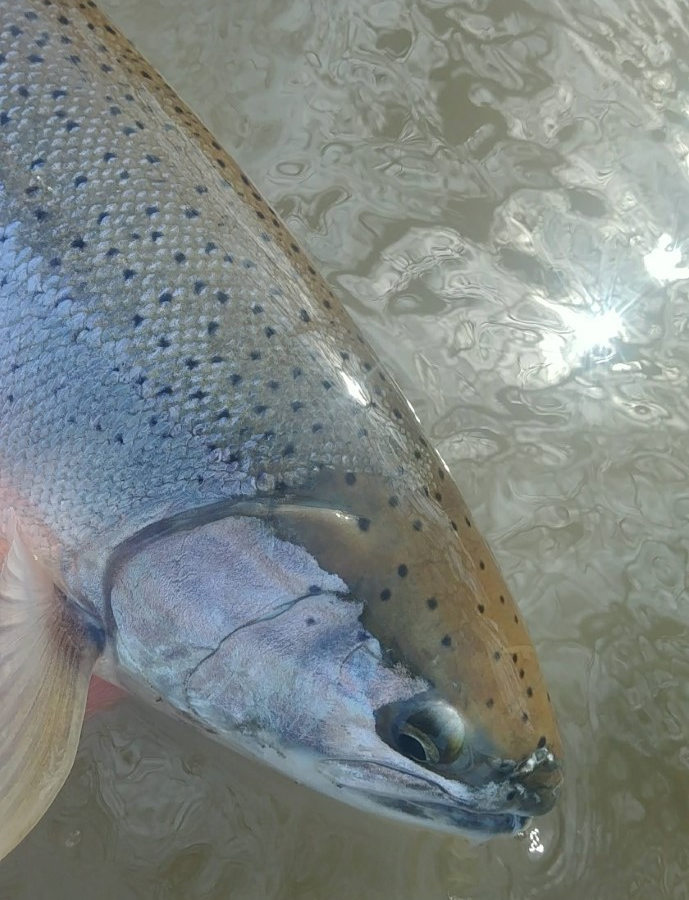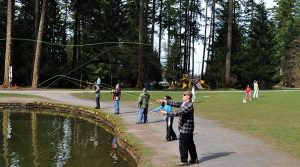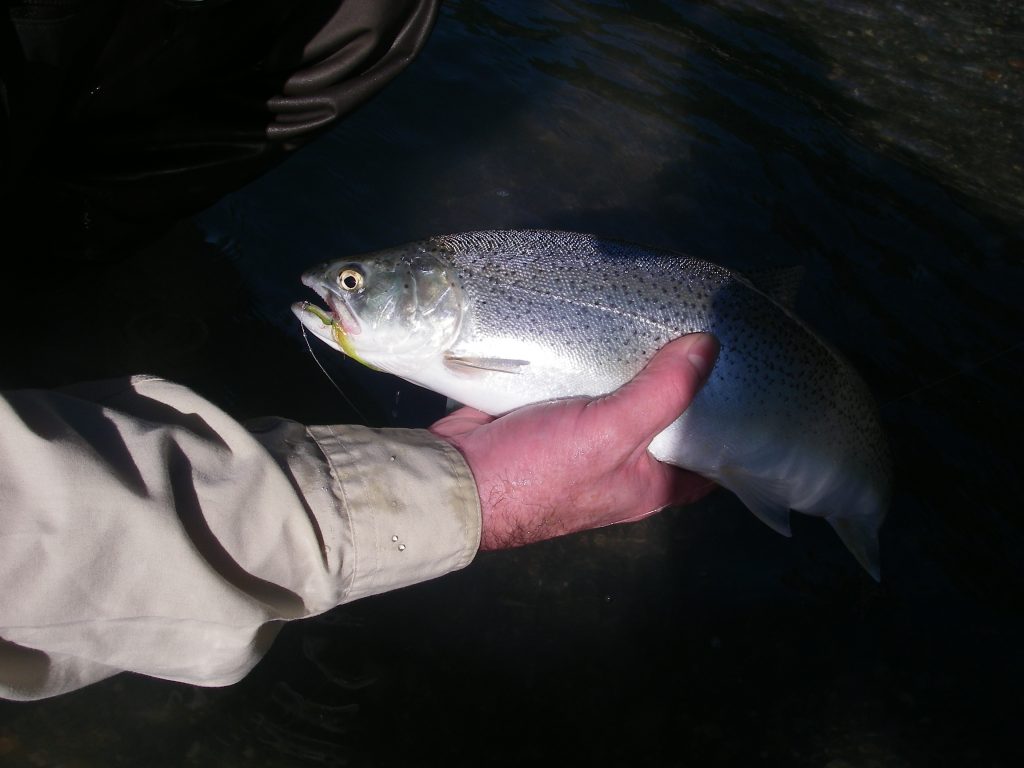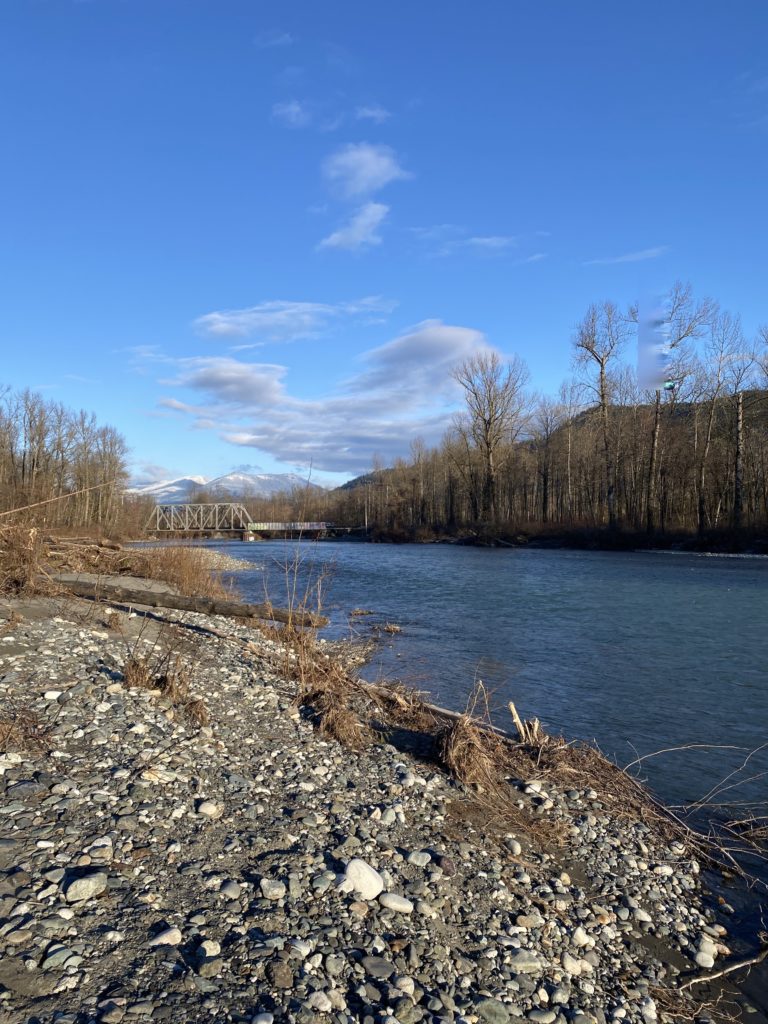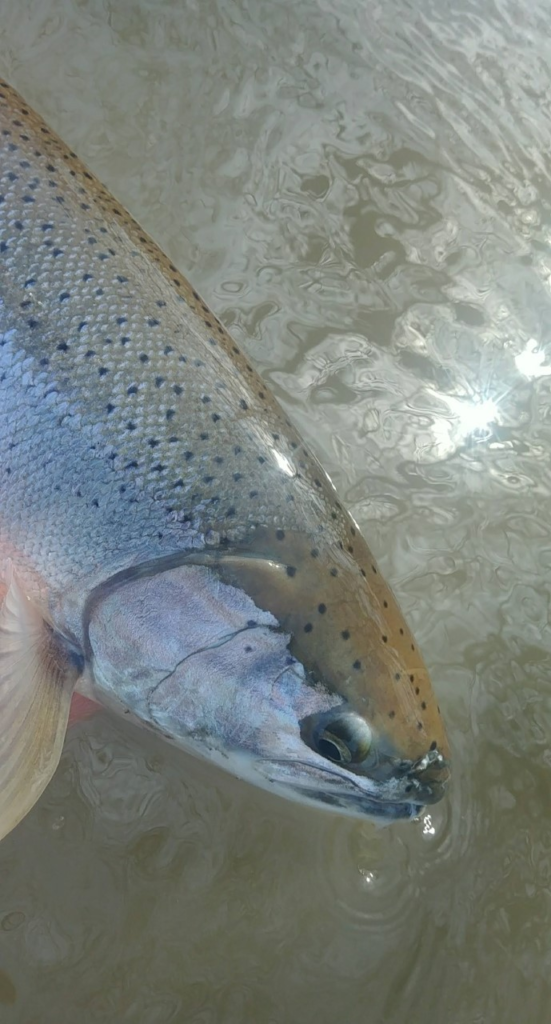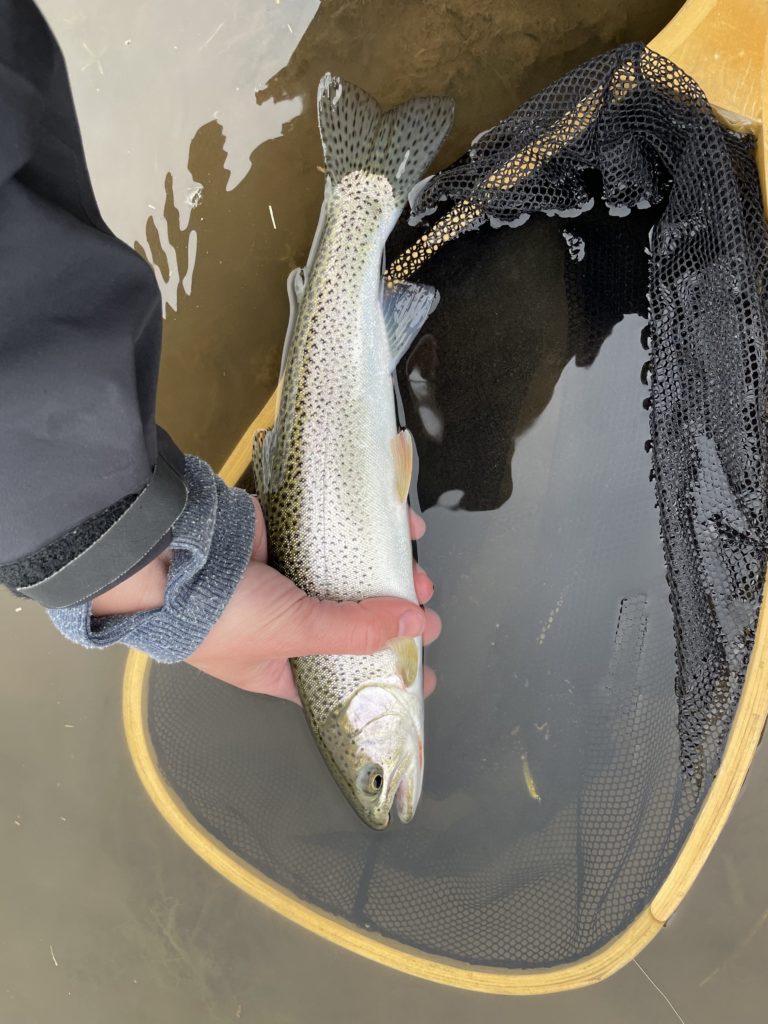OUTLOOK
We didn’t expect the snow yesterday but, at least for fishing, the wet weather coming this weekend should help our river fisheries. With a substantial amount of rain coming, we anticipate river levels to rise nicely. We need this. Most of our systems are low and a bump in water levels should turn on the fish. If the numbers from the weather forecast are correct, we expect levels to rise but not blow out. As always, be sure to check your river levels before you hit the road for your day on the water. If you layer up with good waterproof gear it should be a good weekend to get out.
Below, we have more details on specific systems so be sure to read our freshwater fishing reports section with more details on what we expect.
In this week’s saltwater fishing report, we have more details on the 2022 proposed management measures for the recovery of Southern Resident killer whales and how you can provide your input on these measures.
CLASSES AND COURSES
INTRODUCTION TO FLY FISHING
This course was specifically designed to give the new fly fisher the basic knowledge, casting skills and fly fishing strategies to effectively fish our local BC waters. This course is comprised of two sessions; 3hr evening seminar and a 3hr casting session. The dates below show the seminar date first and casting date second.
Dates: (Mar 8 & 13), (Apr 6 & 9), (May 10 & 14), (Jun 15 & 18), (July 12 & 17), (Sept 20 & 24)
Cost: $150.00 + GST
Zoom Seminar Time: 6:30pm – 9:30pm
Casting Time(s): 10am – 1pm or 1:30pm -4:30pm
FLY FISHING FOR SEARUN CUTTHROAT TROUT IN RIVERS
This spring make sure to get out and take advantage of the world-class cutthroat fishing in the Lower Mainland. This cutthroat course is designed to educate you on the life cycle, location, seasonal feeding habits, and successful techniques and flies used to catch these elusive yet aggressive fish. This course consists of a 3hr evening seminar and a fully guided day on the water.
Dates: Zoom Seminar Mar 23, 2022
Guided Mar 26, 27, Apr 2 or 3, 2022
Zoom Seminar Only Cost: $50.00+GST
Zoom Seminar & Guided Walk’n Wade Cost: $275.00+GST per angler, minimum of 2 anglers per guided day on the water.
Zoom Seminar Time: 6:30pm – 9:30pm Guided: Full Day
FRESHWATER FISHING REPORTS
Chilliwack/Vedder River Fishing Report
This past week we have seen some productive yet cold days on the C/V.
High artic winds made the river uncomfortable to fish for most, but the troopers who remained enjoyed lots of water to fish.
This week is promising as we are expecting the weather to warm up a bit with some rain expected on Saturday through the weekend and into next week. The river sits at a beautiful 2.02m at the time of writing and is not expected to change much drastically from that. Visibility depends on what stretch of river you plan on hitting; areas around Tamahi and the Ranger run slide continue to have visibility around 1-2ft while the lower has 2-3ft of visibility depending on where you are. Techniques remain the same as previous weeks, going bigger and covering water is key.
Stay warm out there,
Gavin Lau
Squamish River Fishing Report
As we write the report, the Squamish is very low. This is not good for fishing as resident fish shut down and anadromous fish don’t move in these conditions. The good news is that this will change this weekend. With 15-20mm forecast for Saturday, and more rain coming through Sunday into early next week, we expect good fishing if we see a noticeable bump in river levels.
With what is in the forecast, we are not sure how much the river will bump. This will be key for planning an outing. As always, the precipitation could dump snow on the upper mountains and not move levels in any appreciable manner. The opposite is also a concern where we could see dirty water from an abrupt river level jump. When we look at historical numbers of precipitation and temperature, the forecast looks good for a “nice” fishing rise so watching river levels the night before you head out will be important. If you get out Saturday, it will probably still be low but as we move into Sunday, Monday and Tuesday, we are hopeful that we will see higher levels and better “green” water conditions.
Long story short, it should be worth getting out over the weekend into next week.
We have not heard reports of salmon fry in any real numbers yet but having a few fry patterns or spoons in your kit is not a bad idea for when you head out.
Dress for wet weather and good luck!
Matt Sharp
Stave River Fishing Report
There’s not a lot going on over at the Stave right now, mainly due to fairly low water levels and the sudden cold snap. There’s a bunch of rain in the forecast for the weekend and next week, so that should bump the water levels a bit and push some fresh fish into the system. It’s been low for a while, so any fish that are in the system have been there for a while and seen a lot of gear. Sizing down your presentation is probably going to be a good idea until the water rises- think beads, blades, small pieces of roe/shrimp, or jigs tied in darker colours.
It’s late February, so I’m expecting some cutthroat trout to start showing up shortly. They’ll be rolling in to feed on salmon fry as they hatch and migrate out to the ocean, so both fly and gear anglers will want to “match the hatch” with small spoons, spinners or fry patterns for the best results.
The Stave is also home to good populations of whitefish, which can provide good entertainment on light tackle. They can be caught fairly easily by either gear or fly anglers; gear anglers will want to stick to small pieces of bait, beads, or small spoons/spinners, while fly anglers can use small nymphs or small minnow patterns. Whitefish are often encountered while targeting cutties and are usually looked down upon as a result. Having said that, they’re willing biters and can be a lot of fun.
Always remember that the Stave is a dam-controlled river and water levels can fluctuate very quickly with little warning, so keep this in mind while fishing, especially when it’s raining
Taylor Nakatani
Cutthroat Primer
Late February means it’s time to start looking for cutthroat and emerging fry. The colder weather will delay fry emergence but hopefully a warm snap over the next couple of weeks triggers some movement. We should see a solid year for cutthroat fishing as pink salmon fry will start to emerge late February / early March. Pink salmon fry are unique as they’ll emerge and head straight out to the ocean from their headwaters. Opportunistic cutthroat will follow the salmon fry and chase them all the way out to the estuaries and river deltas. Pink salmon fry are an extremely easy target for cutthroat as they’re the weakest swimmers. Cutthroat are extremely predatory as they will work together to ball up the fry and then will slash at them. It also makes the cutthroat fishery a ton of fun as it’s visual. I won’t even throw a line in the water until I see either cutthroat boiling or fry skirting across the surface.
We don’t typically see consistent cutthroat days until April since that’s when the largest number of fry will have emerged but, systems like the Harrison, might have a few cutthroat kicking around. The Harrison River has pink, sockeye, chinook, chum, and coho fry meaning that cutthroat fishing can happen all the way from late February until May. A lot of these fry have a long way to travel to the Fraser but there’s always a slim chance that a few fry have already started to work their way into the Harrison where they’ll be greeted by opportunistic cutthroat. The Harrison also has a unique situation as the chinook fry will emerge and then head immediately to the Fraser River. Typically, chinook fry will delay their ocean bound journey for a year or two, but Harrison chinook fry will develop in the Fraser River estuaries instead. The quick emergence and departure mean that most of the fry won’t have even absorbed their yolk sac meaning alevin fry patterns would be my go-to choice if you do end up going out.
Don’t expect a lot if you head out but it’s worth looking around your favorite sloughs to see if a few salmon fry have started to emerge. The cutthroat follow the food so substantial fry activity near the sloughs likely means that the cutthroat won’t be too far behind.
Sterling Balzer
SALTWATER FISHING REPORTS
Vancouver Saltwater Fishing Report
Potential SRKW Measures for the Mouth of the Fraser River:
You may or may not know that there are some proposed SRKW management measures for a lot of important fishing areas, including off the mouth of the Fraser. Some of which would end our September chinook fishery and make it very difficult to fish for sockeye this summer if we get an opening.
These options can be found in a document called the Proposed 2022 Management Measure Options in Support of the Southern Resident Killer Whale Recovery.
You can comment on these options by completing this SURVEY but before you do, please read my personal thoughts on the subject which are specific to the Vancouver area and our fisheries.
There is a document from the Sport Fish Advisory Board that should be out shortly, and it will have detailed information from experts in other areas on how to fill out the survey for those areas if you require assistance. When that document becomes officially available, I will post about it on social media, so make sure you follow Pacific Angler and Pacific Angler Sportfishing on Instagram and Facebook for access to this document. We will put it up on our blog on the Pacific Angler website.
In the meantime, here are my thoughts for the Vancouver area.
After personally talking to a lot of Vancouver anglers, the overwhelming consensus for the Mouth of the Fraser River is for Option 1, status quo. This option will provide significant protection for SRKW when they are present and still allow an important public fishery.
Option 2 or 3 would be devastating to the public on several levels and are not acceptable for reasons that I will be list in detail.
Currently there is a long-standing closure for salmon fishing in Areas 29-6, 29-7, 29-9, 29-11, and 29-12. If SRKW are present, these significant closures are more than adequate to protect their migration in and out of the area and any foraging that may occur.
The local experts, such as the Vancouver Sport Fishing Guides Association (among others) with multiple members having 40 year of fishing experience in this area or more, have spoken in the public process.
These local experts with thousands of hours in this area will tell you the SRKW are not off the Fraser mouth consistently. It is not a staging area. When they do arrive, they are generally moving from S to N in the currently closed areas mentioned above, at a high rate of speed in a consistent direction. Active foraging is rarely observed, and if done, is within the closed areas. The SRKW are usually out of the area entirely within a matter of a few hours, not days or weeks.
Furthermore, there is currently a no fishing for chinook regulation in place in the surrounding Vancouver waters from April 1st to Aug 31st. This adds an additional layer of protection to any SRKW in the area either for migration or foraging purposes.
The aforementioned chinook closure has had devastating social and economic impacts on the people of Vancouver and surrounding areas. The only remaining chinook opportunity is now in the first 2-3 weeks of September when there are fall chinook present off the North Arm and South Arm of the Fraser River. These are predominantly Vedder/Chilliwack chinook of hatchery origin where recent hatchery releases have increased from 1,000,000 to 2,000,000. This is a very modest opportunity in comparison to the previous August fishery of more abundant Thompson 4.1 chinook. Note by September the vast majority of Fraser chinook have already gone up the river with peak migration of chinook into the Fraser occurring on August 21st.
All the Vancouver public has left is the 2-3 week window (Sep 1 to Sep 21) to harvest some fall chinook. Sometimes this opportunity is cut very short with any significant precipitation. These fall chinook are lower river spawners and do not spend much time off the river mouth. When it rains they are gone, effectively ending that years marine opportunity.
Weather is also a consideration. The mouth of the Fraser River is an open water fishery that is subject to significant SE or NW winds that often render the area unsafe to navigate or simply too windy and rough to effectively fish for salmon.
As a result, the rain, wind, or both will often limit the number of days the public will attempt to fish off the mouth of the Fraser for chinook September 1-21. After September 21 the fishing is usually very slow and public participation drops off dramatically. The actual number of days the public is present off the mouth of the Fraser fishing for chinook in September is therefore quite limited. Certainly not 21 days. The reality is approximately 50% of those days are fishable. Many years the effort drops off prior to September 21 because of major precipitation events.
The end result is the actual potential interaction days with SRKW and public fishers is extremely low. The public is just not there on enough days. To compound this, the SRKW are also not there very often. How many days are the SRKW observed from September 1 to September 21 off the mouth of the Fraser? 0, 1, 2 days in those 3 weeks? Combine that with the actual days anglers are present and there are potentially seasons where the interaction with SRKW is 0.
As such, further non-surgical, broad based areas closures should not be accepted or endorsed by the Vancouver public. They are not necessary in this situation and will cause significant social and economic impact to an area that has already been hit very hard by large scale closures.
In addition to the measures in Option 1, and as an alternative to those seeking Options 2 and 3, I suggest adaptive measures. As you can see the actual number of interaction days in September is going to be very low. When they have the potential to occur, there can be measures put in place to further reduce interaction potential, such as VHF broadcasts so anglers or boaters so they can move until the SRKW have passed through. The solutions exist and have been used in other areas. Lack of manpower and funding are not acceptable excuses and not a reason to use large broad-based closures that might have maximum political impact on a press release but very little actual impact for the SRKW.
I also suggest education. The current SRKW avoidance guidelines have not been in place for very long and further education would benefit all boaters, fisher or non-fisher. I believe these guidelines in addition to the existing no fishing for salmon and no fishing for chinook closures provide more than ample protection for SRKW presence of the mouth of the Fraser.
Speaking to public boating safety, I also believe that Option 2 or 3 will create unnecessary public risk, as you will have the public boaters further offshore where there is significant commercial traffic.
Option 2 and 3 would also have a significant impact on the publics ability to fish for sockeye or pinks on years of abundance, noting that 2022 has a high probability of being one of those years for sockeye. It will also push these fishers into areas where there will be significant commercial traffic.
Also note Option 2 or 3 are stated as adding protection for SRKW when foraging increasingly on chum in the fall. The public does not fish for chum in the fall off the mouth of the Fraser. It is not a fishery and never has been. Peak chum migration into the Fraser occurs in the third week of October and there are no boats fishing off the mouth of the Fraser at that time. If SRKW are present in October to forage for chum, there will be no boats there. Chum are not present off the Fraser in the first 3 weeks of September when some boats are present, fishing for chinook. Therefore, no further closures are needed as there are literally no public fishers present when the chum are present.
There are also no public boaters or tourist boaters present when the chum are present. The boating season is over, and the tourist season is over. Previously mentioned NW and SE winds are also very strong in the fall, further increasing the likely hood of no boats being in the area.
Furthermore, there is significant commercial activity in and around the North Arm and South Arm of the Fraser such as commercial crabbing, tugs and barges, tankers, freighters, car carriers, large vessel marine traffic, commercial sight-seeing boats, larger commercial commuter vessels, and the Fraser dredge. All of these activities are immensely louder than boats that are fishing where the emphasis is on being quiet while trolling with efficient and quiet 4-storke engines at low rpm. Our sonar units are also lower wattage than commercial applications.
Why are we looking at shutting down an important but brief fishery that has little or no impact on SRKW migration or foraging when these activities are slated to continue? In particular, the commercial crab boats are of concern. These are large, noisy vessels that operate up on the closed areas to public salmon fishing and set long lines of traps with ropes where the SRKW are transiting or potentially foraging. Is this fishery going to be shut down for the commercial or First Nation operators that are present in this area all summer long and have maximum interaction potential with SRKW on a prolonged and daily basis?
Is the dredge that goes right off the South Arm mouth of the Fraser where the heat map shows peak SRKW occurrence and dumps thousands of liters of turbid water while creating a significant amount of noise going to be shut down as well?
If Option 2 or 3 are accepted, then the public should expect the answer to these questions to be yes.
If Option 2 or 3 are accepted, it would also trigger the responsibility of the government to provide financial assistance to the public fishing businesses affected by this closure as per the SARA (species at risk act) document.
Option 1 is the only option that has balance. It will protect SRKW and take into consideration the social and economic needs of the public. I strongly advise that this is your choice for the mouth of the Fraser River. Please fill out the survey and take the time to add comments where you have the opportunity, this makes your survey input even more valuable.
Jason Tonelli


